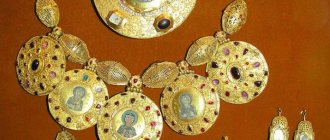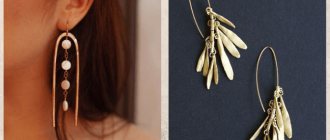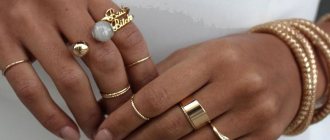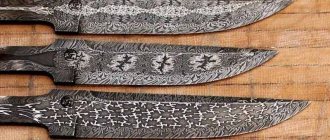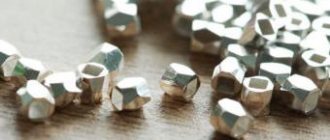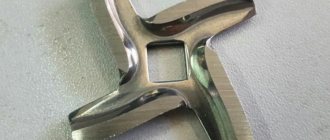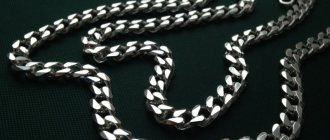What is oxidation
Oxidation is the process of applying a permanent film to a metal surface. There are 2 known methods:
- Chemical. The product is dipped into a liver sulfur solution heated to 70-90 degrees. Afterwards, they are washed in clean water, dried and polished.
- Electrochemical. The product is immersed for 1-5 minutes in an electrolyte consisting of sulfuric acid, sodium sulfide and acetone. The liquid is heated to only 18-22 degrees, and the decoration is kept for no more than 30 minutes.
Oxidation technology can be used both on the entire product and on its individual part. In the first case, the entire product is dipped into the prepared solution, in the second case, the desired area is lubricated with a swab or brush.
The color of oxidized silver can be controlled: the longer you keep the product in the solution, the darker it will be. The technology allows you to obtain a spectrum of shades from gray to black. At the same time, the color applies unevenly: the concave parts become darker, the convex parts become lighter, which gives the product additional volume.
Not only “stoneless” jewelry can be oxidized, but also silver jewelry with stones. If precious inserts can easily withstand high temperatures and exposure to chemical reagents, there is no need to worry about their condition. The color of the stones will not change.
- Blackened silver: technology features, home methods of blackening, care rules
Blackening methods
Over the years of using this metal, many methods and methods of blackening it have accumulated. Can be done at home or by specialists.
- Galvanic method - requires special equipment, is performed only in specialized places;
- Mechanical method - you need to take graphite, mix it with iron oxide and turpentine. After receiving, the mixture is as thick as sour cream. Applied to the product. You need to wait until it dries and wipe with a soft cloth or brush. After this, we wipe it with alcohol and admire our work;
- The chemical method is the safest and most long-lasting. You need to fill the patterns on the product with a mixture consisting of silver sulfide, sulfur, copper and lead. After complete drying, clean the product well with a brush.
How to effectively clean blackened silver: 21 home methods and special products
How is it different from blackening?
There are several differences:
- Ease of manufacture. Blackening is a more labor-intensive process: to implement this technology, you need to prepare the product and apply a design to it by engraving, chasing or etching. Then fill the formed depressions with “black” from a mixture of sulfides and heat until fused with the base. Oxidation is much easier to perform.
- Color. Blackened silver has a deeper and richer shade. Oxidation - less bright, but varied. This technology allows you to achieve a wide range of different shades.
- Price. Oxidized silver on average costs less than blackened silver due to the ease of implementation of the technology.
The value of jewelry depends not only on the chosen technology - oxidation or blackening, but also on the complexity of the work itself.
Varieties of silver
Pure silver has a white color with a silvery tint. But pure silver is too malleable; it cannot be used to make filigree jewelry or a sophisticated box. Therefore, alloys of various metals are added to silver, and depending on the percentage of silver and alloy, the color of the product and its characteristics change. So, today there are several types of silver:
- Matte. They are obtained in different ways: by etching a special emulsion, using a sandblasting machine or a vibroengraver. The product is obtained with a fine-grained rough surface without gloss. Matte silver items look very elegant and unusual. Often such items are chosen as an exclusive decorative gift.
- Coin. Surprisingly, coins were not made from this type of silver, as it might mistakenly seem. Coin silver contains a large percentage of silver (90%) and only 10% copper (rarely nickel or zinc). This alloy composition provides strength and wear resistance to the products. And the name most likely came from ancient times, when people brought silver coins to the master to be melted down. Nowadays coin silver is 900 silver.
- Filigree. This is silver of the highest 960 standard, that is, it consists of 96% silver and 4% alloys of other metals. A thin silver thread is forged from this type of silver and then we form openwork patterns and complex ornaments. Making jewelry from filigree silver is considered a very difficult task, which only true masters can do.
- Blackened. That same silver with the contrast of white and black. Jewelry made from niello looks authentic and sophisticated, and serving items add luxury to any interior. Blackened silver is produced by applying black to pure metal. Next we will look in detail at the methods of blackening silver.
Advantages and disadvantages
Silver jewelry darkens over time. This happens because they come into contact with hydrogen sulfide from the surrounding air. Oxidation allows you to slow down the process: a thin film prevents the silver from oxidizing. True, this defense cannot be called serious - over time, a reaction will still become inevitable.
Oxidation technology gives jewelry additional volume, depth and expressiveness. At the same time, it is safe, does not cause allergic reactions and costs almost nothing. Once the coating is damaged, it can be repaired in a workshop.
Blackening silver at home
You can try the blackening procedure at home. What do we need for this?
- Boiled egg, plastic container, thread and fishing line. Before starting, thoroughly clean your product. Then, cutting the egg into two parts, place it in a container. We hang the silver product on a rope, and seal everything tightly with a lid for half an hour or longer. Periodically turn the product over for uniform blackening;
- Blackening with iodine and sulfur ointment also gives the desired result. Apply iodine to the entire product and leave to dry. After complete drying, wipe thoroughly with a cloth. Sulfur ointment - the same process. Just need to dry it with a hairdryer. If the metal turns purple during drying, then everything is correct. After drying, wipe off the ointment completely.
If you do everything as we recommended, you will get a beautiful piece that will look like antique jewelry.
Rules of care
Oxidized silver does not require complex care. It is enough to clean it from dust and deposits with a soft napkin or cloth soaked in a weakly concentrated soap solution. The use of abrasives and aggressive detergents containing ammonia and solvents is prohibited.
To preserve the attractiveness of the jewelry for a long time, you should protect it from mechanical influences. Oxidized silver does not stain the skin, but it is better to avoid strong friction, especially when wearing rings. Such jewelry also needs to be stored separately.
Video
How to care for silver
To prevent silver from turning black, jewelers coat the product with rhodium. This material protects silver, which is susceptible to sulfur compounds, and helps it remain shiny.
Caring for silver jewelry
In addition, in order to protect the precious metal from patina, you should properly care for your silver jewelry - clean and polish it regularly, remove it when taking a shower or washing dishes, and do not play sports while wearing your jewelry.
Silver should be stored in a special box or case with soft upholstery. It is best to fold jewelry so that they do not touch each other - this way you will avoid scratches and chips.
Text author: Alexandra Tsiklauri
Result
Oxidized silver acquires a noble color. The convex parts have a pronounced shade.
Silver products after oxidation
The metal shimmers with new colors, the decoration changes color and appearance. Silver can turn black, gray, blue, purple, and the resulting color is retained by the jewelry for several years.
The film completely covers the silver and protects it from external factors. If oxidation is carried out for a product with stones, then you should not worry about their safety. Gemstones will not change color because only the metal reacts.
Immersion in a solution of sulfur liver helps to change a familiar product beyond recognition.
The oxidation process takes 30–40 minutes, it helps to give the jewelry a different color, increase its resistance to external factors, and affect its appearance. Silver treated in this way does not darken. The film protects the jewelry, but gradually it becomes thinner, so the procedure can be repeated several times, changing the color of the metal as desired.
Source
Effectiveness of the result
After oxidation, silver acquires a beautiful noble color. Protruding parts are shaded with a black surface. The metal begins to shine, shimmering with new colors, jewelry changes color and appearance. With proper care, products retain their aesthetic and functional qualities for a long time.
The process of oxidizing silver items chemically lasts no more than 40 minutes. The resulting film can protect the jewelry, but over time it wears off and “exposes” the metal. Therefore, the procedure can be repeated several times, changing the color of the metal as desired.
Treated silver should be cleaned carefully, without rough tools or compounds that can damage the oxide layer. It is safer to clean the precious metal with a soft cloth and a mild soap solution.
In a situation where it is necessary to carry out the reverse procedure - to remove the oxide layer, the silver is placed in a soap solution, and then in a 10% solution of citric acid or ammonia. After this, the oxidized film begins to disintegrate and can simply be removed with a hard toothbrush or sponge.
Protective black film can protect jewelry from mechanical influences and other external factors. If you choose oxidation technology, then you don’t need to worry about the safety of precious inserts. They will not change color, darken or collapse, since only the metal reacts.
Features of the result
During oxidation, silver jewelry is treated with sulfur, which gives the silver a brighter, more saturated hue. Due to the formed protective film, new colors appear that are preserved for a long time.
Polishing allows you to highlight the convex parts of the product, as their natural shine returns, and the concave parts acquire a pronounced dark shade.
The resulting protective layer has an increased level of strength, so the silver will be protected from various types of adverse external influences. In addition, thanks to the surface layer, the silver will not darken.
Oxidized silver requires no maintenance . However, if you need to clean silver jewelry, you need to be extremely careful, because using brushes can damage the thin protective layer.
Therefore, it is recommended to either use the services of a jewelry workshop, or carry out gentle cleaning using a dry cloth and rags treated with soapy water.
Unfortunately, over time, the protective oxidized layer tends to thin out, so after a certain period of time it is recommended to repeat the sulfur treatment procedure.
See the following video for the silver oxidation process.
Source
